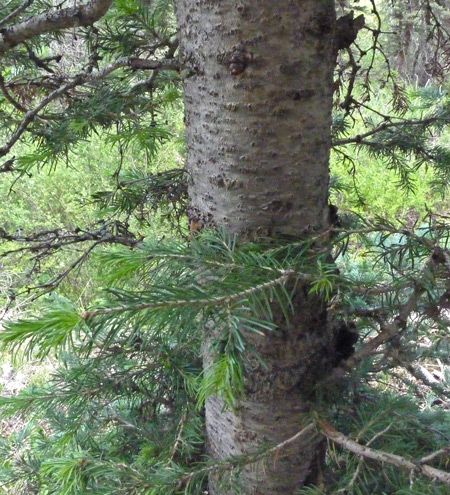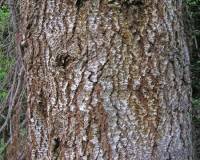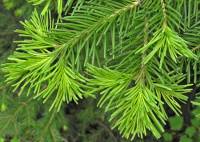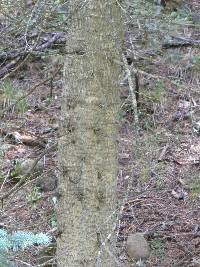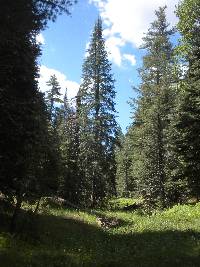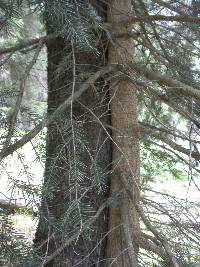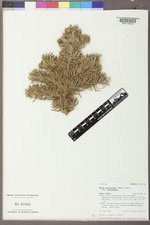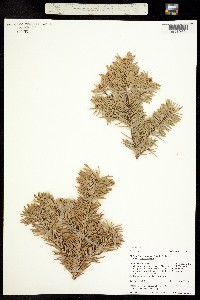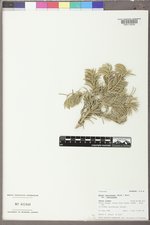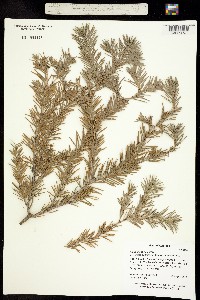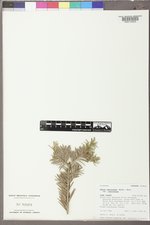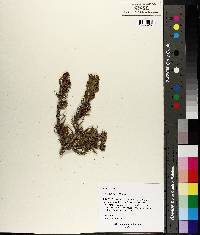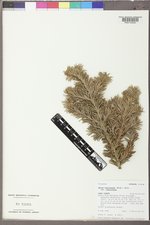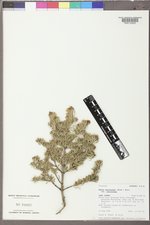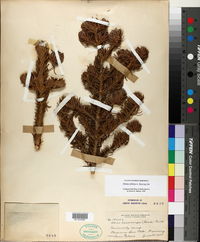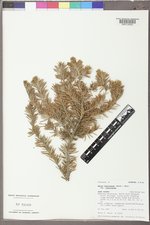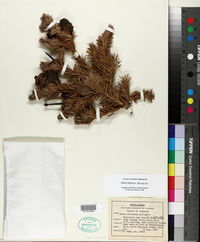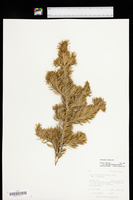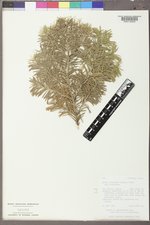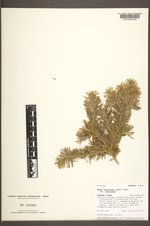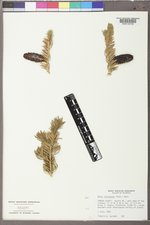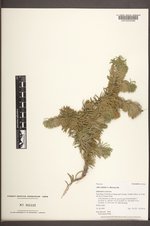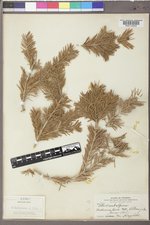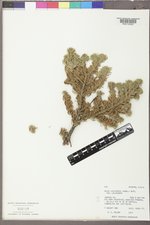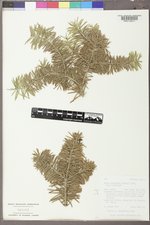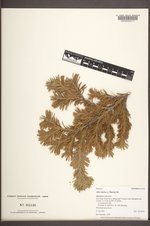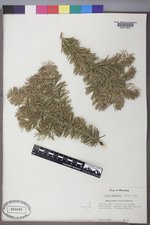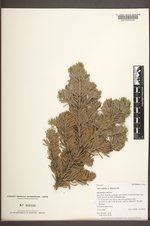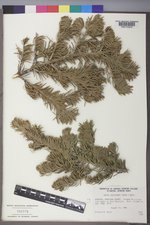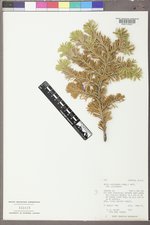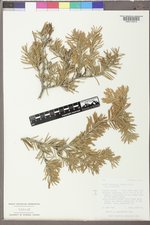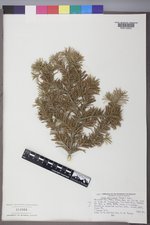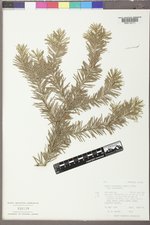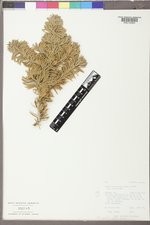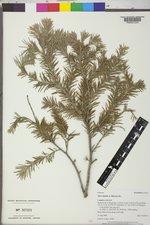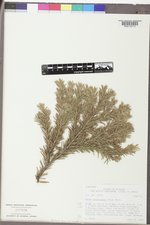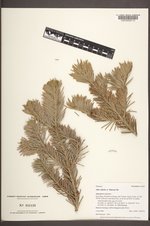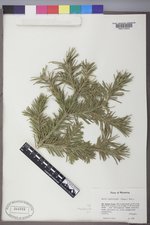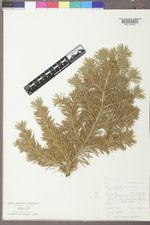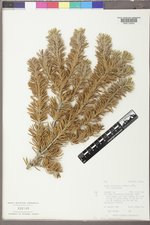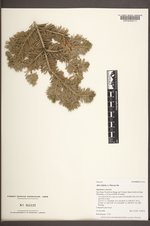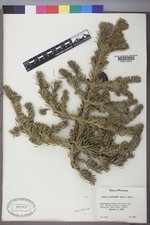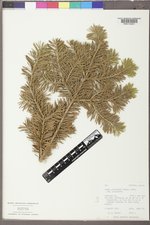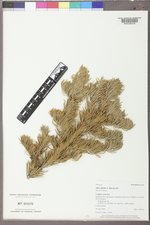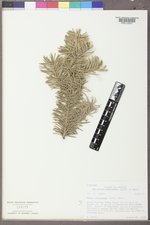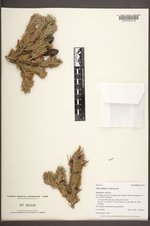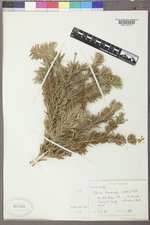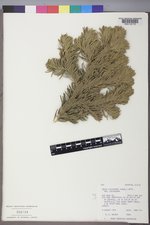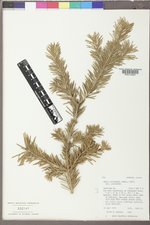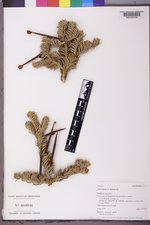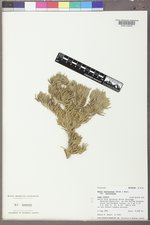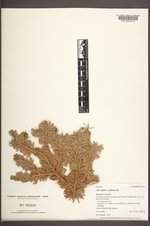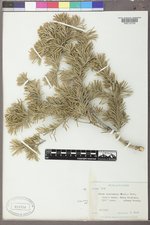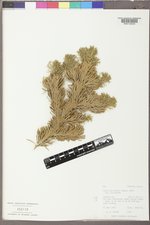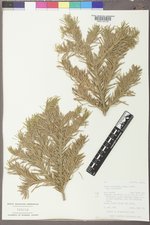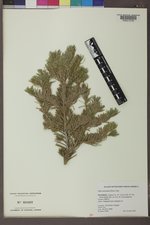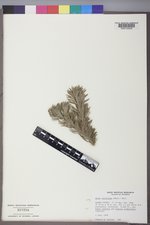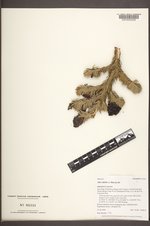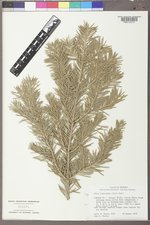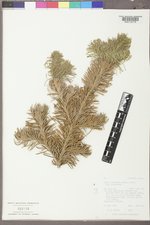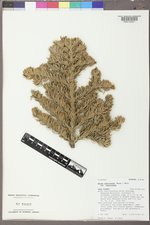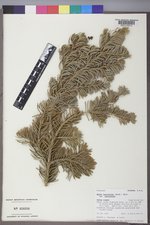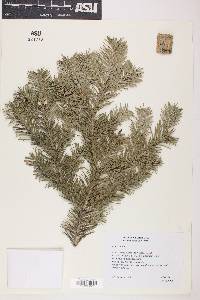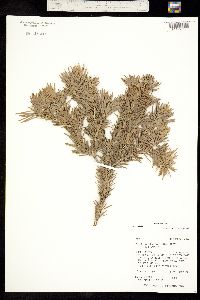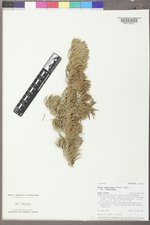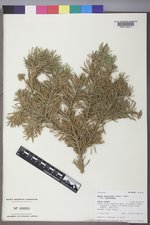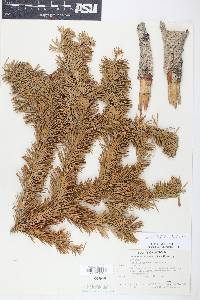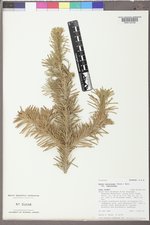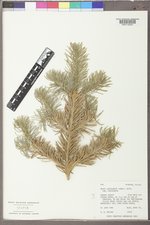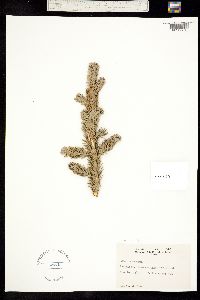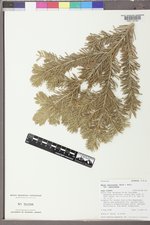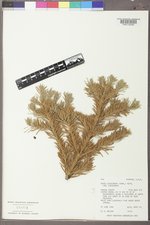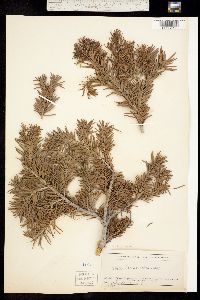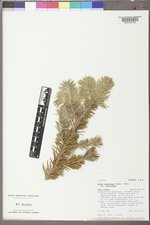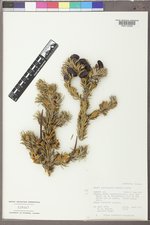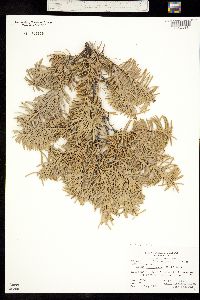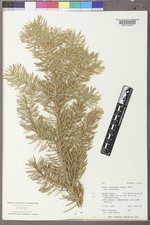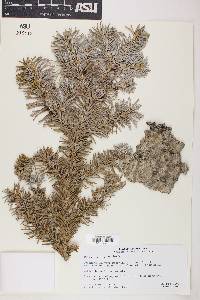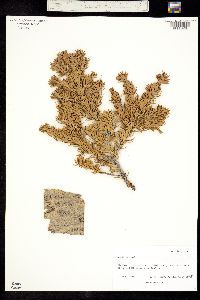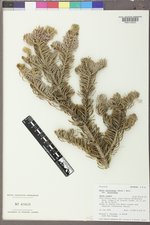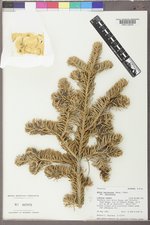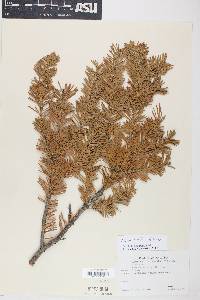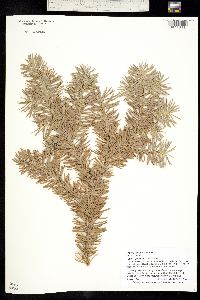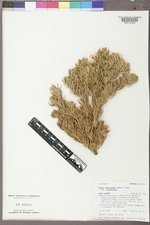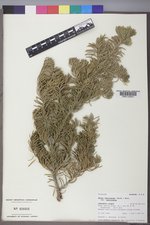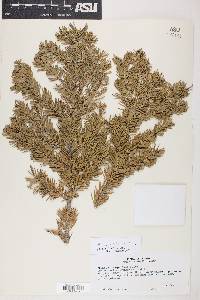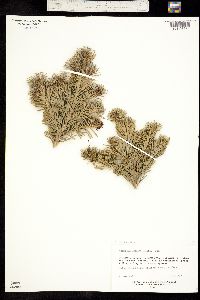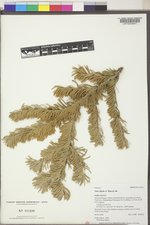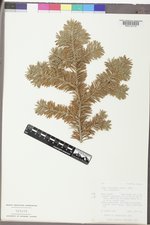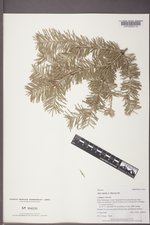Abies bifolia
|
|
|
|
Family: Pinaceae
Rocky Mountain Alpine Fir
[Abies lasiocarpa subsp. bifolia (A. Murray bis) Silba] |
Trees to 30m; trunk to 0.45m diam.; crown spirelike. Bark gray, thin, smooth, with age somewhat furrowed and scaly (toward southern end of range bark is corky [corkbark fir]). Branches diverging from trunk at right angles, stout, stiff; twigs opposite to whorled, grayish, pubescence sparse, light brown; fresh leaf scars with light brown periderm. Buds exposed, brown, globose, small, resinous, apex rounded; basal scales long, narrow, isosceles triangular to spatulate, glabrous, resinous or not resinous, margins entire to rarely crenate, apex sharp-pointed or rounded. Leaves 1.1--2.5cm × 1.25--1.5mm, spiraled and turned upward, flexible; cross section flat, grooved adaxially, sometimes only slightly so; odor camphorlike; abaxial surface with 3--5 stomatal rows on each side of midrib; adaxial surface light green to bluish green, usually glaucous, with 3--6 stomatal rows at midleaf, rows usually continuous to leaf base, usually more numerous toward leaf apex; apex slightly notched to rounded; resin canals large, ± median, away from margins and midway between abaxial and adaxial epidermal layers. Pollen cones at pollination purplish. Seed cones cylindric, 5--10 ´ 3--3.5cm, dark purple-blue to grayish purple, sessile, apex rounded; scales ca. 1.5 ´ 2.5cm, densely pubescent; bracts included. Seeds 5--7 ´ 2--3mm, body brown; wing about 1.5 times as long as body, grayish brown; cotyledons 3--6. Continental, subalpine coniferous forests; 600--3600m; Alta., B.C., N.W.T., Yukon; Ariz., Colo., Idaho, Mont., Nev., N.Mex., Oreg., Utah, Wash., Wyo. Abies bifolia has been---and by many workers still is---included in synonymy under A . lasiocarpa or A . subalpina since about 1890, and A . subalpina under A . lasiocarpa since about the 1920s. Abies bifolia is distinct from A . lasiocarpa , however, in chemical tests on wood (H.S. Fraser and E.P. Swan 1972), lack of crystals in the ray parenchyma (R.W. Kennedy et al. 1968), lack of lasiocarpenonol (J.F. Manville and A.S. Tracey 1989), and distinct terpene patterns (R.S. Hunt and E.von Rudloff 1979). Abies bifolia also tends to have slightly shorter and fewer prominently notched leaves than A . lasiocarpa . The two are clearly separated by the color of their periderm and by the shape of their basal bud scales. These firs may be more distinct than the pairs A . balsamea -- A . fraseri and A . procera -- A . magnifica . A north-south transect, however, from south central Yukon to northern Washington yielded introgressed trees possessing characteristics of both A . lasiocarpa and A . bifolia , recalling the interior spruce (Canadian Forestry Service 1983), which has characteristics of both Picea glauca and P . engelmannii . These trees can similarly be called interior subalpine fir, i.e., A . bifolia ´ lasiocarpa . Both A . lasiocarpa and A . bifolia need comparative morphologic studies. Isolated southern populations of Abies bifolia may also have unique characteristics. The taxonomy of corkbark fir, treated by some as A . lasiocarpa var. arizonica (Merriam) Lemmon, is uncertain. This taxon should probably be a segregate of A . bifolia , not A . lasiocarpa , a disposition that requires a thorough morphologic and chemical reappraisal, especially since the work of E.Zavarin et al. (1970) suggested that populations south of Wyoming may have unique terpene patterns. In north central Alberta, A . bifolia introgresses with A . balsamea (R.S. Hunt and E.von Rudloff 1974; E.H. Moss 1953).
General: Evergreen tree, up to 30 m (100 ft) tall, often dwarfed and shrub-like at timberline; trunk to 0.6 m in diameter; crown narrow, spire-like; branches stiff, straight, lower branches pendulous; twigs opposite to whorled, grayish, with sparse, light brown pubescence, and slightly depressed circular leaf scars; buds blunt to rounded, small, tan, resinous. Gray, smooth, with resin blisters on young trees; gray to creamy white, thick, furrowed, scaly, and corky on mature trees. Needles: Needles, spirally arranged, solitary, linear, flat, 1.2-4 cm long, those of the lower branches 2-3 cm long, bluish green to dark blue-green; the adaxial (upper) surface grooved and bearing white stomatal lines, the abaxial (lower) surface with stomatal lines separated by a raised midvein; apex rounded or notched; needles with a pungent, camphor-like odor. Cones: Male and female cones on same tree; male (pollen) cones 5-8 mm long, bluish to purplish; female (seed) cones cylindric, 5-10 cm long, dark purple, erect, the scales densely pubescent; seeds 5-7 mm long, brown, winged. Ecology: Rocky slopes, subalpine coniferous forests; 1100-3700 m (3600-12000 ft); Apache and Coconino counties; western Canada, western and southwestern U.S. Notes: Taxonomic confusion exists with regard to southern populations of Abies bifolia. Authorities in the southwestern U.S. treat the species as A. lasiocarpa var. arizonica. The Flora of North America (1993) suggests that the species should be a segregate of A. bifolia, but recognizes that the southern populations in its distribution have unique characteristics. To date, the taxonomy is unresolved. Abies concolor is distinguished from A. bifolia by its dark gray and furrowed bark on mature trees, longer needles on the lower branches, and yellowish green to greenish purple or grayish green female (seed) cones. Subalpine fir is a shade-tolerant species that exhibits very little tolerance to fire; fir stands typically suffer high mortality from even low- intensity surface fires. It is attacked by numerous insects and is susceptible to various fungal rots. Seeds are wind-dispersed, and bare mineral soil provides a good seed bed; however, seeds require cold, moist stratification for germination. This species provides excellent cover for many species. Seeds are eaten by many mammals and birds, and the foliage has some browse potential for ungulates. It is used extensively by northern tribes for food, fiber, and medicine, and provides Christmas trees, lumber, and pulpwood products. However, it is not a commercially valuable timber species due primarily to the inaccessibility of the areas where it is found. |

